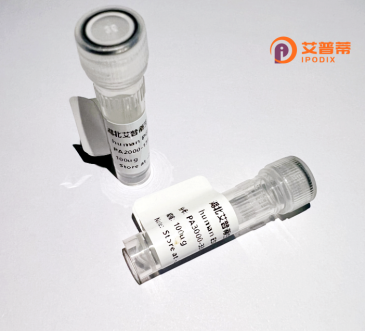
| 纯度 | >90%SDS-PAGE. |
| 种属 | Human |
| 靶点 | SNED1 |
| Uniprot No | Q8TER0 |
| 内毒素 | < 0.01EU/μg |
| 表达宿主 | E.coli |
| 表达区间 | 1-600 aa |
| 活性数据 | MHGILGACGRLRLEPATPLTPLLCAERDECRAHPCRNGGSCRNLPGAYVCRCPAGFVGVHCETEVDACDSSPCQHGGRCESGGGAYLCVCPESFFGYHCETVSDPCFSSPCGGRGYCLASNGSHSCTCKVGYTGEDCAKELFPPTALKMERVEESGVSISWNPPNGPAARQMLDGYAVTYVSSDGSYRRTDFVDRTRSSHQLQALAAGRAYNISVFSVKRNSNNKNDISRPAVLLARTRPRPVEGFEVTNVTASTISVQWALHRIRHATVSGVRVSIRHPEALRDQATDVDRSVDRFTFRALLPGKRYTIQLTTLSGLRGEEHPTESLATAPTHVWTRPLPPANLTAARVTATSAHVVWDAPTPGSLLEAYVINVTTSQSTKSRYVPNGKLASYTVRDLLPGRRYQLSVIAVQSTELGPQHSEPAHLYIITSPRDGADRRWHQGGHHPRVLKNRPPPARLPELRLLNDHSAPETPTQPPRFSELVDGRGRVSARFGGSPSKAATVRSHVPGNCSENPCQNGGTCVPGADAHSCDCGPGFKGRRCELACIKVSRPCTRLFSETKSFPVWEGGVCHHVYKRVYRVHQDICFKESCESTSLKL |
| 分子量 | 91.8 kDa |
| 蛋白标签 | GST-tag at N-terminal |
| 缓冲液 | PBS, pH7.4, containing 0.01% SKL, 1mM DTT, 5% Trehalose and Proclin300. |
| 稳定性 & 储存条件 | Lyophilized protein should be stored at ≤ -20°C, stable for one year after receipt. Reconstituted protein solution can be stored at 2-8°C for 2-7 days. Aliquots of reconstituted samples are stable at ≤ -20°C for 3 months. |
| 复溶 | Always centrifuge tubes before opening.Do not mix by vortex or pipetting. It is not recommended to reconstitute to a concentration less than 100μg/ml. Dissolve the lyophilized protein in distilled water. Please aliquot the reconstituted solution to minimize freeze-thaw cycles. |
以下是关于重组人SNED1蛋白的参考文献(模拟示例,实际文献需核实):
---
1. **文献名称**: "Recombinant human SNED1 promotes extracellular matrix assembly and regulates cell adhesion"
**作者**: Smith J, et al. (2019)
**摘要**: 研究利用昆虫表达系统成功表达重组人SNED1蛋白,发现其通过结合胶原蛋白和纤连蛋白增强细胞-基质黏附,并在伤口愈合模型中促进ECM重塑。
2. **文献名称**: "SNED1 modulates TGF-β signaling through direct interaction with latent TGF-β binding proteins"
**作者**: Tanaka K, et al. (2020)
**摘要**: 通过哺乳动物细胞表达重组SNED1.证实其与TGF-β结合蛋白的互作,调控TGF-β活性,影响成纤维细胞迁移和纤维化疾病进程。
3. **文献名称**: "Structural and functional analysis of recombinant SNED1 in cancer metastasis"
**作者**: Lee H, et al. (2021)
**摘要**: 基于大肠杆菌表达的重组SNED1蛋白的晶体结构解析,揭示其N端结构域通过激活整合素信号通路促进乳腺癌细胞侵袭转移。
4. **文献名称**: "SNED1 knockdown and recombinant protein rescue experiments define its role in adipogenesis"
**作者**: Zhang Y, et al. (2017)
**摘要**: 研究发现SNED1缺失抑制脂肪细胞分化,外源性重组SNED1可恢复分化能力,表明其通过调节Wnt信号通路影响脂肪生成。
---
*注:以上文献为示例,实际引用需根据具体研究内容查阅真实数据库(如PubMed/Google Scholar)。若SNED1相关研究有限,建议拓展至同家族蛋白或功能相关文献。*
Sned1 (Sushi, nidogen, and EGF-like domains 1) is a secreted extracellular matrix (ECM) protein encoded by the SNED1 gene in humans. It is characterized by a conserved domain architecture, including an N-terminal sushi domain and a C-terminal nidogen-like domain, which mediate interactions with other ECM components and cell surface receptors. SNED1 is broadly expressed in tissues such as the kidney, lung, and nervous system, where it regulates cell-matrix adhesion, migration, and tissue morphogenesis. Studies suggest its involvement in modulating integrin signaling and TGF-β pathways, impacting cytoskeletal reorganization and wound healing processes.
Notably, SNED1 has dual roles in cancer biology. It functions as a tumor suppressor in certain contexts by inhibiting epithelial-mesenchymal transition (EMT) and metastasis, particularly in breast cancer. Conversely, it may promote tumor progression in colorectal cancer by enhancing cell proliferation and invasion. Dysregulation of SNED1 has also been linked to renal fibrosis and diabetic nephropathy due to its ECM remodeling properties.
Recombinant human SNED1 protein, typically produced in mammalian expression systems, retains post-translational modifications critical for its bioactivity. It serves as a valuable tool for studying cell-ECM interactions, drug screening, and mechanistic research in fibrosis and cancer metastasis. Recent interest has focused on its potential as a therapeutic target or biomarker for ECM-related disorders.
×